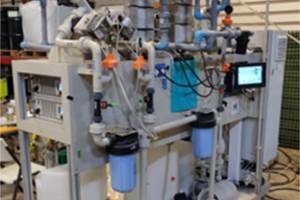Copper Plateback
We have a rack line where we run our zinc and tin plating, and we are noticing when soaking copper parts, in our alkaline soak cleaner, that our steel parts will acquire a dark film on them, when removed from the soak, to go into the electrocleaner. What would be causing this?
Q. We have a rack line where we run our zinc and tin plating, and we are noticing when soaking copper parts, in our alkaline soak cleaner, that our steel parts will acquire a dark film on them, when removed from the soak, to go into the electrocleaner. We are thinking that prolonged soak cycles of copper parts are somehow releasing something in the soak bath that then films itself on our steel parts that are soaked in the same soak cleaner. What would be causing this? MP
A. The phenomenon you are experiencing most often occurs in an uninhibited acid cleaning solution for mixed metals, specifically copper or copper alloy products that is also used to clean steel products. It is called copper plate back and it occurs less with alkaline cleaners.
The cause of this is the tendency for some copper to become dissolved in the process of cleaning where it will exist as a copper ion in solution. When some iron is then dissolved (or oxidized), there is an automatic chemical thermodynamic driving force that will plate (or reduce) the copper back onto the steel. The standard reduction potentials for copper and iron are as follows:
Cu+2(aq) + 2e- Cu(s) E = 0.337V
Fe+2(aq) + 2e- Fe(s) E = -0.440V
Giving the overall reaction as follows:
Cu+2(aq) + 2e- Cu(s) E = 0.337V
Fe(s) Fe+2(aq) + 2e- E = 0.440V
Fe(s) + Cu+2(aq) Fe+2(aq) + Cu(s) E = 0.777V
The positive voltage for the overall reaction indicates this is a spontaneous reaction that proceeds in the forward direction. The reason this occurs less with an alkaline cleaner is that it is less aggressive in attacking and dissolving base metal than an acid solution would be. Additionally, there are precipitates that may form with copper in an alkaline solution that may remove some or all of the copper. These competing side reactions do not occur in an acid solution.
If you want to minimize or eliminate this from your cleaning process, there are a couple possible steps you can take. One would be to use a less aggressive cleaner. From your description, I would guess there is a fair amount of free caustic in your cleaner that will dissolve the copper. The high level of free caustic the pH of the solution will then also prevent most of the copper from precipitating. A less aggressive, moderately alkaline cleaner will have a tendency to put less copper in solution and will precipitate more of the copper as a metal hydroxide if the pH is not as high.
Another alternative would be to use an inhibited alkaline cleaner. This would include additives that would minimize the base metal attack of either the copper, steel or both. As can be seen from the overall reaction, eliminating either the steel or copper from reacting would not allow the reaction to go forward since it has essentially eliminated one of the reactants. Talk to your chemical sales representative to evaluate your process and make a recommendation based on your conditions.
Related Content
Improving Wastewater Management Efficiency
Don’t find yourself underwater when managing wastewater processes. Follow these steps to improve efficiency and determine the best ROI.
Read MoreTTX Environmental Solves Customer Issue with Electro-Ceramic Desalination Wastewater Processing
Electroplating facility without access to a drainage system found a safe solution for wastewater treatment and reuse.
Read MoreClean Technology Lasers for Coating Adhesion
Laser cleaning systems remove corrosion, grease, residue and existing coatings from metal surfaces quickly, with less preparation and mess than traditional techniques.
Read MoreFrom Drain to Gain with Smart Wastewater Recovery
Incorporating digital monitoring to maximize performance.
Read MoreRead Next
Delivering Increased Benefits to Greenhouse Films
Baystar's Borstar technology is helping customers deliver better, more reliable production methods to greenhouse agriculture.
Read MoreA ‘Clean’ Agenda Offers Unique Presentations in Chicago
The 2024 Parts Cleaning Conference, co-located with the International Manufacturing Technology Show, includes presentations by several speakers who are new to the conference and topics that have not been covered in past editions of this event.
Read MoreEducation Bringing Cleaning to Machining
Debuting new speakers and cleaning technology content during this half-day workshop co-located with IMTS 2024.
Read More


























